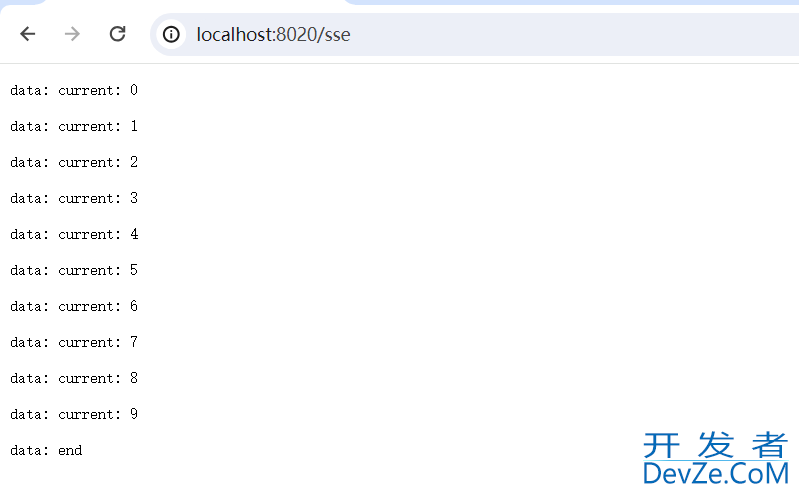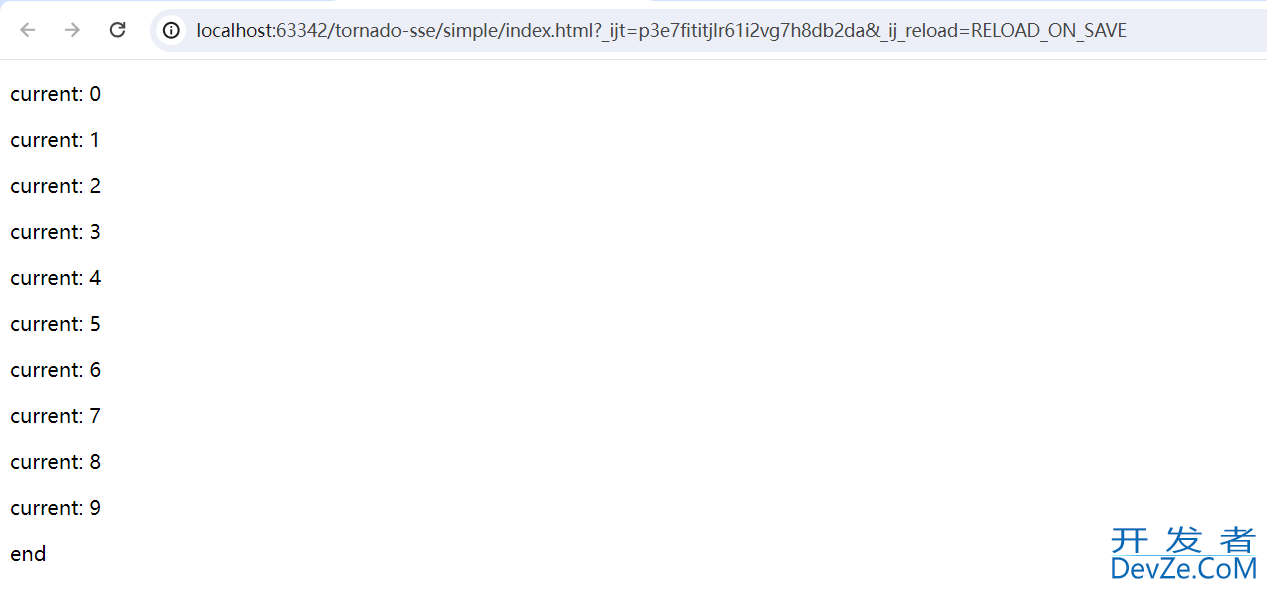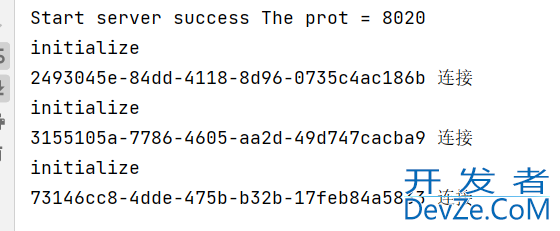Python Tornado 实现SSE服务端主动推送方案
目录
- 一、SSE 服务端消息推送
- 二、短暂性场景下的 SSE 实现
- 三、长连接场景下的 SSE 实现
一、SSE 服务端消息推送
SSE 是 Server-Sent Events 的简称, 是一种服务器端到客户端(浏览器)的单项消息推送。对应的浏览器端实现 Event Source 接口被制定为html5 的一部分。相比于 WebSocket,服务器端和客户端工作量都要小很多、简单很多,而 Tornado 又是python中的一款优秀的高性能web框架,本文带领大家一起实践下 Tornado SSE 的实现。
本文主要探索两个方面的实践:一个是客户端发送请求,服务端的返回是分多次进行传输的,直到传输完成,这种情况下请求结束后,就可以考虑关闭 SSE了,所以这种连接可以认为是暂时的。另一种是由服务端在特定的时机下主动推送消息给到客户端,推送的时机具有不确定性,随时性,所以这种情况下需要客户端和服务端保持长久连接。
本次使用的 Tornado 版本:
tornado==6.3.2
二、短暂性场景下的 SSE 实现
短暂性场景下就是对应上面的第一点,客户端主动发送请求后,服务端分多次传输,直到完成,数据获取完成后连接就可以断开了,适用于一些接口复杂,操作步骤多的场景,可以提前告诉客户端现在进行到了哪一步了,并且这种方式也有利于服务端的横向扩展。
在 Tornado 中实现,需要注意的是要关闭 _auto_finish ,这样的话就不会被框架自己主动停止连接了,下面是一个实现的案例:
import time
from tornado.concurrent import run_on_executor
from tornado.web import RequestHandler
import tornado.gen
from concurrent.futures.thread import ThreadPoolExecutor
class SSE(RequestHandler):
def initialize(self):
# 关闭自动结束
self._auto_finish = False
print("initialize")
def set_default_headers(self):
# 设置为事件驱动模式
self.set_header('Content-Type', "text/event-stream")
# 不使用缓存
self.set_header('Content-Control', "no-cache")
# 保持长连接
self.set_header('Connection', "keep-alive")
# 允许跨域
self.set_header('Access-Control-Allow-Origin', "*")
def prepare(self):
# 准备线程池
self.executor = self.application.pool
@tornado.gen.coroutine
def get(self):
result = yield self.doHandle()
self.write(result)
# 结束
self.finish()
@run_on_executor
def doHandle(self):
tornado.ioloop.IOLoop.current()
# 分十次推送信息
for i in range(10):
time.sleep(1)
self.flush()
self.callback(f"current: {i}")
return f"data: end\n\n"
def callback(self, message):
# 事件推送
message = f"data: {message}\n\n"
self.write(message)
self.flush()
class Application(tornado.web.Application):
def __init__(self):
handlers = [
("/sse", SSE),
("/(.*)$", tornado.web.StaticFileHandler, {
"path": "resources/static",
"default_filename": "index.html"
})
]
super(Application, self).__init__(handlers)
self.pool = ThreadPoolExecutor(200)
def startServer(port):
app = Application()
httpserver编程客栈 = tornado.httpserver.HTTPServer(app)
httpserver.listen(port)
print(f"Start server success", f"The prot = {port}")
tornado.ioloop.IOLoop.current().start()
if __name__ == '__main__':
startServer(8020)
运行后可以到浏览器访问:http://localhost:8020/sse,此时就可以看到服务端在不断地推送数据过来了:

那如何在前端用 js 获取数据呢,前面提到在 JS 层面,有封装好的 Event Source 组件可以直接拿来使用,例如:
<!DOCTYPE html>
<html lang="en">
<head>
<meta charset="UTF-8">
<title>测试服务器推送技术</title>
</head>
<body>
<div id="messages"></div>
</body>
<script>
const eventSource = new EventSource('http://localhost:8020/sse');
// 事件回调
eventSource.onmessage = (event) => {
console.log(event.data)
const messagesDiv = document.getElementById('messages');
messagesDiv.innerHTML += '<p>' + event.data + '</p>';
};
// 异常
eventSource.onerror = (error) => {
console.error('EventSource failed:', error);
eventSource.close();
};
eventSource.onopen = ()=>{
console.log("开启")
}
</script>
</html>
运行后可以看到服务端分阶段推送过来的数据:

三、长连接场景下的 SSE 实现
上面实现了客户端请求后,分批次返回,但是有些情况下是客户端连接后没有东西返回,而是在某个特定的时机下返回给某几个客户端,所以这种情况,我们需要和客户端保持长久的连接,同时进行客户端连接的缓存,因为同时有可能有 100 个用户,但是推送时可能只需要给 10 个用户推送,这种方式相当于将一个客户端和一个服务端进行了绑定,一定程度上不利于服务端的横向扩展,但也可以通过一些消息订阅的方式解决类似问题。
下面是一个实现案例:
import time
from tornado.concurrent import run_on_executor
from tornado.web import RequestHandler
import tornado.gen
from concurrent.futures.thread import ThreadPoolExecutor
# 单例
def singleton(cls):
instances = {}
def wrapper(*args, **kwargs):
if cls not in instances:
instances[cls] = cls(*args, **kwargs)
return instances[cls]
return wrapper
# 订阅推送工具类
@singleton
class Pusher():
def __init__(self):
self.clients = {}
def add_client(self, client_id, callback):
if client_id not in self.clients:
self.clients[client_id] = callback
print(f"{client_id} 连接")
def send_all(self, message):
for client_id in self.clients:
callback = self.clients[client_id]
print("发送消息给:", client_id)
callback(message)
def send(self, client_id, message):
callback = self.clients[client_id]
print("发送消息给:", client_id)
callback(message)
class SSE(RequestHandler):
# 定义推送者
pusher = Pusher()
def initialize(self):
# 关闭自动结束
self._auto_finish = False
print("initialize")
def set_default_headers(self):
# 设置为事件驱动模式
self.set_header('Content-Type', "text/event-stream")
# 不使用缓存
self.set_header('Content-Control', "no-cache")
# 保持长连接
self.set_header('Connection', "keep-alive")
# 允许跨域
self.set_header('Access-Control-Allow-Origin', "*")
@tornado.gen.coroutine
def get(self):
# 客户端唯一标识
client_id = self.get_argument("client_id")
self.pusher.add_client(client_id, self.callback)
def callback(self, message):
# 事件推送
message = f"data: {message}\n\n"
self.write(message)
self.flush()
# 定义推送接口,模拟推送
class Push(RequestHandler):
# 定义推送者
pusher = Pusher()
def prepare(self):
# 准备线程池
self.executor = self.application.pool
@tornado.gen.coroutine
def get(self):
# 客户端标识
client_id = self.get_argument("client_id")
# 推送的消息
message = self.get_argument("message")
result = yield self.doHandle(client_id, message)
self.write(result)
@run_on_executor
def doHandle(self, client_id, message):
tornado.ioloop.IOLoop.current()
self.pusher.send(client_id, message)
return "success"
class Application(tornado.web.Application):
def __init__(self):
handlers = [
("/sse", SSE),
("/push", Push),
("/(.*)$", tornado.web.StaticFileHandler, {
"path": "resources/static",
"default_filename": "index.html"
})
]
http://www.devze.com super(Application, self).php__init__(handlers)
self.pool = ThreadPoolExecutor(200)
def startServer(port):
app = Application()
httpserver = tornado.httpserver.HTTPServer(app)
httpserver.listen(port)
print(f"Start server success", f"The prot = {port}")
tornado.ioloop.IOLoop.current().start()
if __name__ == '__main__':
startServer(8020)
这里我定义了一个 Pusher 订阅推送工具类,用来存储客户端的连接,以及给指定客户端或全部客户端发送消息,然后我又定义 Push 接口,模拟不定时的指定客户端发送信息的场景。
同样前端也要修改,需要给自己定义 client_id ,例如:
<!DOCTYPE html>
<html lang="en">
<head>
<meta charset="UTF-8">
<title>测试服务器推送技术</title>
</head>
<body>
<div id="client"></div>
<div id="messages"></div>
</body>
<script>
function generateUUID() {
let uuid = 'xxxxxxxx-xxxx-4xxx-yxxx-xxxxxxxxxxxx'.replace(/[xy]/g, function(c) {
const r = Math.random() * 16 | 0;
const v = c === 'x' ? r : (r & 0x3 | 0x8);
return v.toString(16);
});
return uuid;
}
// 利用uuid 模拟生成唯一的客户端ID
let client_id = generateUUID();
document.getElementById('client').innerHTML = "当前 client_id = "+client_id;
const eventSource = new EventSource('http://localhost:8020/sse?client_id='+client_id);
// 事件回调
eventSource.onmessage = (event) => {
console.log(event.data)
const messagesDiv = document.getElementById('messages');
messagesDiv.innerHTML += '<p>' + event.data + '</p>';
};
// 异常
eventSource.onerror = (error) => {
console.error('EventSource failed:', error);
eventSource.close();
};
eventSource.onopen = ()=>{
console.log("开启")
}
</script>
</html>
这里我用 uuid 模拟客户端的唯一ID,在真实使用时可不要这么做。
下面使用浏览器打开三个页面,可以看到三个不同的 client_id :




下面调用 push 接口来给任意一个客户端发送消息,例如这里发给client_id = 24930http://www.devze.com45e-84dd-4118-8d96-0735c4ac186b 的用户 :

下面看到 client_id 是 2493045e-84dd-4118-8d96-0735c4ac186b的页面:



都没有消息,到这里就实现了长连接下不定时www.devze.com的服务端消息推送方案。
到此这篇关于Python Tornado 实现SSE服务端主动推送方案的文章就介绍到这了,更多相关Python SSE服务端内容请搜索编程客栈(www.devze.com)以前的文章或继续浏览下面的相关文章希望大家以后多多支持编程客栈(www.devze.com)!





 加载中,请稍侯......
加载中,请稍侯......
精彩评论